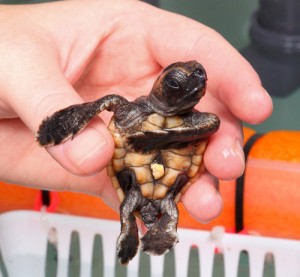
ASSATEAGUE — It was good news, bad news this week as just one of the loggerhead turtle hatchlings rescued from the beach on Assateague in advance of Hurricane Sandy has lived, but the tiny survivor is well on the road to rehabilitation.
On Friday, Oct. 26, just about two days before Hurricane Sandy arrived in the mid-Atlantic area, biological technicians and other staff from the Marine Animal Rescue Program (MARP) of the National Aquarium in Baltimore excavated a loggerhead sea turtle nest from the north end of Assateague Island National Seashore in advance of the storm. The loggerhead nest, one of the first viable ever discovered on Assateague, contained three live hatchlings and 160 potentially viable eggs, which had been incubating in the warm sand since the end of July.
The excavation of the nest was planned because the window for viability of the hatchlings and eggs was ready to expire, but the pending arrival of Sandy expedited the project. National Aquarium Stranding Coordinator Jennifer Ditmar said this week the nest was discovered in late July and had been closely monitored throughout the late summer and early fall.
“The rangers on Assateague were making their daily rounds on the beach when they discovered a crawl and they confirmed there was a nest and marked off the area,” she said. “They monitored the nest every day and we know from our research and experience the eggs typically hatch within 60 to 70 days. If it gets to 90 days, the chances of successful hatchings goes down, which is why we were planning to excavate the nest.”
Ditmar said the imminent arrival of Hurricane Sandy in the area in and around Assateague and Ocean City moved up the timetable for the planned excavation.
“It had been scheduled for about two weeks, but we knew we had to act fast with the storm approaching,” she said. “It was quite a surprise to find the three live hatchlings, although most of the eggs that weren’t hatched would not have made it. The sand was already too cold for the eggs to incubate. If the cold didn’t kill them, the storm almost certainly would have.”
Even before the planned excavation and the arrival of the storm, the nest and its pending arrivals got a little help from an unlikely source. Because sea turtle hatchlings naturally look for residual light in the night sky reflecting off the ocean when they emerge from the nest, there was concern the young turtles would move toward an artificial light source across the Inlet north of Assateague when they hatched.
In preparation for the newly hatched loggerheads, Harrison’s Harbor Watch restaurant, which is known for its bright lights illuminating the Inlet, agreed to turn off its artificial light source that shines toward the north end of Assateague and the nesting turtles.
The entire nest, including the three live hatchlings, were carefully packed in sand and taken back to the National Aquarium in Baltimore. Unfortunately, two of the live hatchlings succumbed to infections. In addition, each of the remaining eggs were carefully monitored and no more live hatchlings were discovered.
“Two of the hatchlings expired two days after being hatched,” said Ditmar. “We then went through each of the remaining eggs one by one to see if there were any more live hatchlings, but unfortunately, none of the others survived.”
However, one of the live hatchlings survived and is well on the road to adulthood and a potential re-release.
“We do have one live hatchling and he’s doing very well so far,” she said. “It started eating on its own for the first time on Sunday and that’s very good sign. That’s a very important milestone. It’s on antibiotics and vitamin treatments and is doing very well.”
Ditmar said the loggerhead hatchling will be carefully monitored and administered treatment at the National Aquarium throughout the winter until such time as it is ready for a release into the ocean. While the nest was discovered on Assateague, it appears likely the young loggerhead recuperating at the National Aquarium will be released somewhere much farther south.
“There’s a good chance we’ll coordinate with our colleagues in North Carolina for the release when the time is right,” said Ditmar. “Loggerhead nestings are much more common down there and they have more experience than we do with raising hatchlings and re-releasing them.”
Ditmar said the young sea turtle rescued in advance of Hurricane Sandy is thriving in the meantime.
“We’re kind of taking it as it comes, but so far, so good,” she said. “The fact he is already eating is a very good sign.”
Thus far, the hatchling has not been named and it could be a chore left for the staff at Assateague Island National Seashore.
“It’s really their baby,” said Ditmar. “We’re just the nannies so to speak until it’s ready to be released.”
